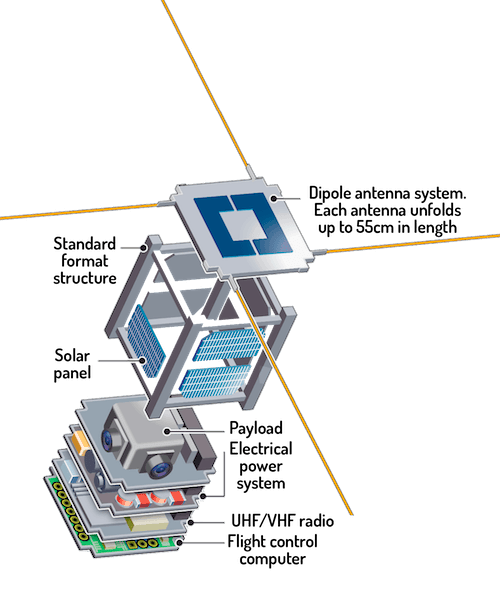Introduction to CubeSats
How Small Satellites (CubeSat) are Manufactured: CubeSats, small satellites typically measuring 10x10x10 centimeters, are reshaping the satellite industry. Their compact design and affordability make them accessible to a wide range of organizations, from universities to small businesses. Unlike traditional satellites, CubeSats can be developed and launched quickly and cost-effectively.
This democratization of space has sparked a wave of innovation. CubeSats are now being used for a variety of applications, including Earth observation, telecommunications, and scientific research. Their ability to collect timely and extensive data is driving advancements in numerous fields.
CubeSats: Revolutionizing Space Exploration
The versatility of CubeSats is another key advantage. Equipped with various instruments, they can perform diverse tasks, from capturing Earth images to conducting space experiments. This flexibility, coupled with rapid development times, makes CubeSats invaluable tools for addressing emerging challenges and opportunities in space.
As technology continues to evolve, the potential of CubeSats is limitless. They are poised to play an increasingly significant role in space exploration and utilization. Also see https://scienceandaerospace.blog/how-satellites-orbit-the-earth/
How Small Satellites (CubeSat) are Manufactured: The Design Process of Small Satellite
The design phase of CubeSats is a critical step that lays the foundation for the entire satellite construction process. It begins with defining the mission objectives, which serve as the driving force behind design choices. These objectives determine key elements such as the satellite’s intended operations, operational environment, and the specific payload it will carry. Clarity in mission goals ensures that the CubeSat is tailored to meet the necessary functional requirements and constraints.
Moreover, payload specifications are pivotal considerations during the design stage. Engineers must account for the measurements, weight, and power consumption of the instruments that the CubeSat will house. This forms a crucial aspect of the design, as it influences the structural integrity, thermal management, and power distribution systems within the satellite. Additionally, the design process must incorporate analyses of power requirements to ensure that the CubeSat can efficiently gather and manage energy, typically sourced from solar panels.
The Role CAD Play:
To facilitate the design work, engineers and designers utilize advanced tools, such as computer-aided design (CAD) software. These tools allow for precise modeling, simulation, and visualization of the CubeSat’s components, promoting a better understanding of the overall system. Different simulations are run to predict the behavior of the CubeSat in various environments, including temperature fluctuations and orbital dynamics. Prototyping plays a crucial role in this stage, enabling teams to create tangible models to test and validate the design before production.
The design process of CubeSats requires significant collaboration among engineers, scientists, and stakeholders. Open discussions and interdisciplinary teamwork ensure that all aspects of satellite design meet practical needs while optimizing functionality and efficiency. This comprehensive approach ultimately leads to the successful production of compact and effective CubeSats capable of fulfilling their mission objectives.
Manufacturing CubeSats: How Small Satellites (CubeSat) are Manufactured: A Focus on Precision and Efficiency
CubeSat manufacturing relies on a combination of techniques and materials to create lightweight, durable satellites capable of surviving the harsh conditions of space.
3D Printing: A Leap Forward 3D printing has revolutionized CubeSat production. By building objects layer by layer, furthermore this additive manufacturing process enables the creation of complex geometries and intricate components. This rapid prototyping technique allows designers to iterate quickly, minimizing waste and accelerating development time.
CNC Machining: Shaping Precision CNC machining, a subtractive manufacturing process, is essential for shaping precise components from solid blocks of material. Lightweight and strong materials like aluminum and carbon fiber are commonly used in CubeSat construction, and CNC machining ensures these components meet the demanding requirements of space.
Electronics Assembly: The Heart of the Satellite CubeSats integrate numerous sensors, communication systems, and microcontrollers. Electronics assembly involves carefully selecting and assembling these components to create reliable and efficient systems. In addition custom circuit boards and microcontrollers are often used to optimize performance and minimize size.
Quality Assurance: A Priority Quality assurance is paramount throughout the manufacturing process. Rigorous testing of materials and components, as well as thorough inspections, ensure that each CubeSat meets the highest standards of reliability. By prioritizing quality, manufacturers can extend the operational lifespan of these small satellites and maximize their scientific potential.
Testing and Launch Preparations for CubeSats

CubeSat Testing: A Rigorous Process
Thermal Vacuum Testing: CubeSats undergo a series of rigorous tests to ensure their functionality and resilience in the harsh space environment. One crucial test is thermal vacuum testing, which simulates the extreme temperatures and vacuum conditions of space. Engineers subject the satellite to various temperature cycles, monitoring the performance and integrity of all onboard systems. This ensures that components can operate efficiently under the demanding conditions of orbit.
Vibration Testing: Another critical test is vibration testing, which evaluates the structural integrity of the satellite during launch. As a result launch vehicles generate significant vibrations, and it’s essential that the CubeSat can withstand these forces without damage. Engineers use specialized equipment to replicate these vibrations, ensuring that components like solar panels, antennas, and sensitive instruments remain intact.
Functional Testing Functional tests verify that all CubeSat systems operate as intended. These tests assess communication links, propulsion systems, and software functionalities. By identifying and addressing any issues before launch, engineers can ensure the satellite’s readiness for its mission.
Launch Preparation and Integration After successful testing, the CubeSat is integrated with a launch vehicle. This process requires meticulous planning and coordination with space agencies to ensure timely and accurate launch operations.
In conclusion, to sum up, in short rigorous testing and meticulous preparation of CubeSats are essential for mission success. These processes enhance the reliability of CubeSats thus ensure their ability to withstand the challenges of space exploration, making them invaluable tools for scientific advancement.

